Have you ever debated whether humour would be appropriate for your social media content strategy? It works for other brands so why not yours?
As marketers turn to target growing demographics like Millennials and Gen Y (and Z), it has become evident that a great shift in thinking has occurred. Younger generations are open and responsive to humour, especially when it comes to social media.
We’ve seen many brands successfully sell their products or services using humour through social media. And it makes sense: think about your personal preferences on social media, someone who shares funny content is definitely on my newsfeed because I find it entertaining. In fact, entertaining content was one of the top five reasons people follow particular brands or individuals online.
But why exactly does it work and what can we learn from brands who have previously used humour as a core part of their strategy? I went on a mission to find out. But don’t jump to conclusions, humour isn’t always appropriate so let’s discuss when its best to exhibit caution, and how to make sure humour fits your brand.
Without further ado, here are four reasons why humour works on social media:
- It makes brand more human
- Clearly communicates your current (or new) brand position
- Funny content spreads
- People like to be entertained
1. It makes your brand more human
Incorporating humour into your strategy can help give your brand a more human side which is always refreshing to customers in this ever-growing technological world. This can really benefit your brand as it helps you build a connection with the online community.
Just look at the success TikTok and all of the brands on it had!
When your humour is relevant to everyday human pains, current trends or live events, audiences can easily relate. Leveraging these moments shows your audience that you’re not just firing off automatic tweets but actually sending them at the moment – in the same way, they would behave. As a brand, you are therefore able to move away from the tradition of talking at your customers and share experiences with them instead.
This is particularly effective when brands piggyback off the digital amplification of major events like Oreo did during the Super Bowl XLVII blackout. More recently we’ve seen brands like White Castle and Juicy Fruit make light of celebrity feuds and viral trends that made headlines on several social platforms.
Juicy Fruit jumped on the ‘Dad Bod’ phenomenon to create this clever ad that features their different types of gum packs. They found a subtle yet humorous way to incorporate a hot trend into their brand content.
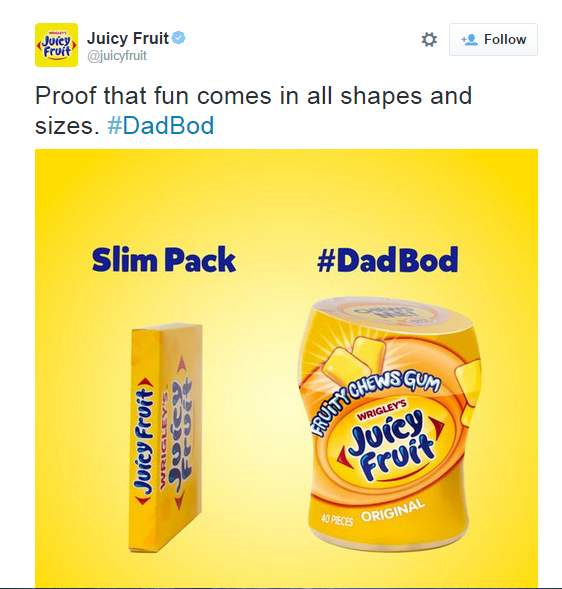 Source: Juicy Fruit Twitter
Source: Juicy Fruit Twitter
What can you learn from these brands? If you want to inject humour into your strategy, do it in a way that shows you’re up to date with current trends and are eager to relate with your audiences. Most importantly find a relevant, yet subtle, connection that lets your brand personality shine.
2. Clearly communicates your current (or new) brand position
While humour can help you relate to your current audience it can also help you attract a new audience and rebrand. This is definitely a strategy that needs to be well thought out but, if done successfully can completely transform the way people view your brand.
So who has done this well? Clorox was able to take a dull product and bring it life through social media. They took a brand that has been around for more than 100 years and gave it a digital presence with humorous content that clearly drives home their product’s use.
Below you can see how they found a way to promote their product with the popular #WineWednesday hashtag.
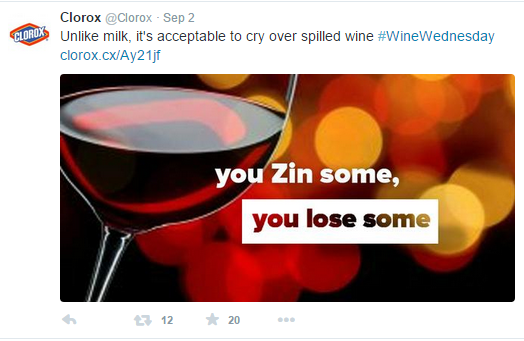 Source: Clorox Twitter
Source: Clorox Twitter
Another example of their fun personality is seen in the tweet below. Instead of blatantly giving consumers nine ways to use their product, they offer nine ways to make a mess. A much more fun and engaging way to communicate their product message.
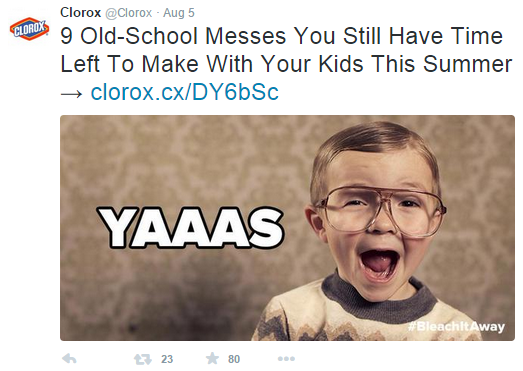 Source: Clorox Twitter
Source: Clorox Twitter
Along the same lines, for a company like Dollar Shave Club, social media humour was an opportunity for them to stand out from the competition. Their use of humour on social media helped them redefine how men’s razor blades are viewed in a highly controlled (and dominated) market. Unlike their competitors, the Dollar Shave Club focuses on a social media strategy, that is, they only promote their products via social media channels including Youtube, Facebook, Twitter and Instagram (Fast Company). Although others in the industry are active on social platforms as well, Dollar Shave Club’s sarcastic, funny and laidback humour makes their brand personality shine. As you can see from the examples below, they encourage their followers to join in on the fun of their humorous content.
This tweet gets customers to create their own #RazorBurn meme.
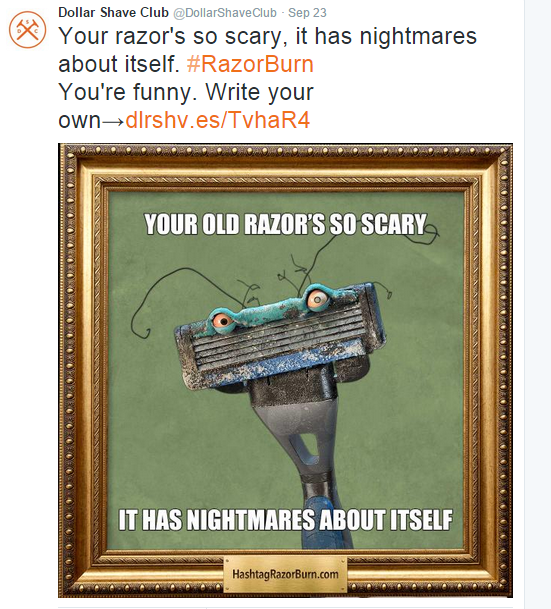 Source: Dollar Shave Club Twitter
Source: Dollar Shave Club Twitter
They also feature several posts similar to the one below showing customers in a quirky selfie or image with Dollar Shave Club’s products. They encourage other customers to get involved in the conversation and entice them with free shirts. It’s simple, engaging and perfectly communicates their ‘don’t take yourself to seriously’ brand.
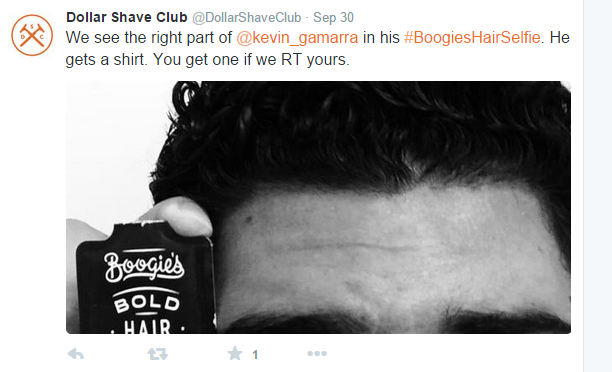 Source: Dollar Shave Club Twitter
Source: Dollar Shave Club Twitter
What can you learn from Clorox and Dollar Shave Club? First, social media can bring your product to life, no matter what it is. Second, having a highly engaged social following gives you access to more qualified leads because you are connecting with people who actually want to see your content.
3. Funny content spreads
One of the most common reasons why brands use humour is that it’s a common denominator in viral content. In fact, it was proven in a study that humour was the universal appeal for making content go viral (Moz). Why do brands want this? Aside from huge exposure it also makes the brand memorable.
Take Clash of Clans for example, their Revenge commercial starring Liam Neeson, which aired during the 2015 Superbowl, garnered more than a million shares and has over 75 million views on Youtube. They spoofed Neeson’s well known Taken character and made it into a humorous commercial to promote their product. The memorable clip helped the app move to the 24th most downloaded app on an iPhone from 38 before the commercial aired.
We’ve also seen brands incorporate content that has already gone viral from users of social media platforms to leverage the humour for their brand. For example, Chelsea Hanger, became a Youtube sensation after her husband filmed her singing a Salt-N-Peppa song. Within a few months, the video had over 16 million views, Hanger was invited to be a guest on the Ellen DeGeneres show and then featured in a TV commercial for Acura, advertising the 2015 Acura RDX. At the time the video went viral, Acura was looking for a fun-spirited female for their commercial and she absolutely fit the bill. The brand was able to leverage an already viral (and well-known) moment to communicate their product’s brand message.
What can you learn from these brands? Viral content can come from anywhere. Whether it’s from user generated content, a big brand budget, or an unexpectedly funny tweet, social media has the power to spread your message like a wildfire. So be open-minded when it comes to your source of humorous content.
4. People like to be entertained
The final reason why humour works in social media is quite simply that it evokes emotion and laughter. This is beneficial for brands because laughter is social. It brings people together. So, when a brand creates memorable, humorous content, it can easily become a conversation piece in social settings.
Just think about that meme you emailed your co-worker last week or tagged your friend in on Instagram. Having sharable content gives brands more exposure and hopefully more customers. Ergo, another reason humour works in social media. So what brand is known for making memorable content on social media and cause a laugh or two? That would be Taco Bell.
Taco Bell has infamously used social media to connect with their target market using content they want to see. Their Instagram account has gained more than 600 000 followers by posting playful content (often from followers) that combine products images with playful millennial-geared taglines and pop culture references.
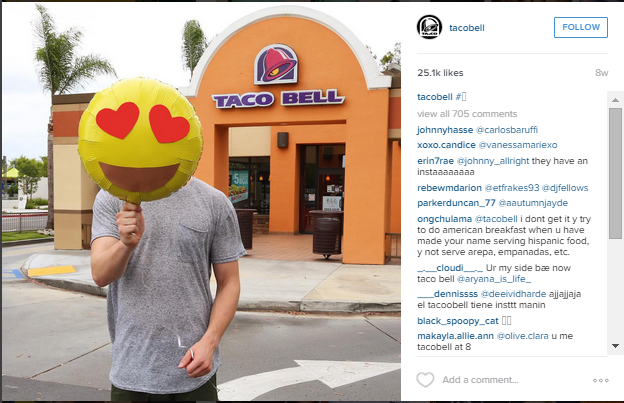 Source: Taco Bell Instagram
Source: Taco Bell Instagram
What can you learn from Taco Bell’s social strategy? If you’re going to use humour, cater it to your audience. Understand what makes them laugh and if you nail this, it will be even easier to incorporate user generated content into your social feeds.
As you can see, using humour in social media can definitely work for brands BUT there a few things you should consider before tweeting that ‘punny’ joke, hilarious meme or sarcastic comment.
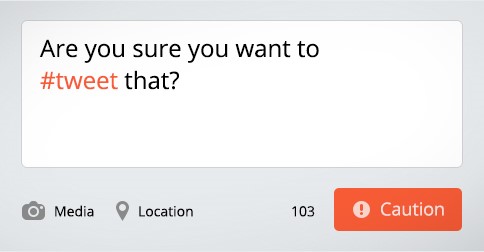
First, when considering humour in your social media you need to have the right tone. Bruce Daisley, UK Twitter Director, suggests using the tone of voice triangle when using the platform as a marketing tool. The tone of voice triangle includes fun, help and info; Daisley believes a brand should choose two of the three to direct their tone of voice and let the third tone be a secondary priority. Following this guide ensures your brand has a consistent tone of voice and dose of humour so that your audience isn’t surprised by that funny post your about to send out.
Second, you need to know when it’s appropriate to use humour and when it is not. Trying to spin a joke out of a serious tragedy or event will not benefit your social strategy or your brand for that matter. An example of humour gone wrong was when Kenneth Cole tried to take advantage of the Twitter conversation regarding protests in Cairo. They tweeted:
“Millions are in uproar in #Cairo. Rumor is they heard our new spring collection is now available online at http://bit.ly/KCairo-KC.” (Kenneth Cole Twitter)
This is a sure-fire way to cause an uproar for your brand and not in a good way. Humour, of course is always subjective so you can’t expect to please everyone all the time. But you should know the difference between subject matter that’s humorous vs. offensive or insulting.
Third, understand how your audience views you. What kind of relationship do you have with your audience? What kind of voice would they expect you to have? Being customer-centric when it comes to your content will also help you determine the right combination of tones to use. This is exactly what Taco Bell has done to grow their social media following; understand their audience and deliver what they want. Remember, customers are choosing your brand for a reason- don’t scare them away with unexpected, non-relatable or unwanted content.
The way I see it, using humour in social media is two sided. On the one hand it can help you build a relationship with your audience and garner attention in the digital world. But on the other hand, the content and humour needs to be the right fit for your brand so that you are sending a consistent message. If you’re starting to explore your brand’s funny bone then learn from the success of others that are doing it well and build a strategy that will make your brand shine.




